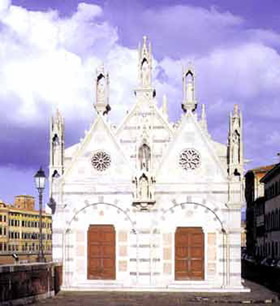Pisa - Church of Santa Maria della Spina

The church of Santa Maria della Spina is considered a jewel of the Italian Gothic art. Its name, which was given to the church in 1333, originates from a thorn of Christ's crown that a Pisan merchant brought into Pisa put it inside the church when he returned from the Holy Land.
Originally, the church of Santa Maria de Pontenovo (this is how it was called during its first century of existence) was located near a bridge, the Pontenovo, that was destroyed in the XV century and which had never been rebuilt.
It had been a small oratory until 1322, when the enlargement works directed by Lupo di Francesco started.
Currently, the church is set on the Lungarno Gambacorti, but at the time of its construction, in 1230, it rose on the Arno's right bank. In the XIX century, it was dismantled and transferred to avoid it being damaged by the frequent river floods, something that instead happened to numerous ancient buildings in the following century. It was also decided to substitute the original statues with copies.
Nevertheless, this way the Pisans deprived the building of its ancient sacristy that, after being destroyed, changed the structure of the complex for ever.
The facade of the church is divided into two perfectly symmetrical parts with two portals surmounted by two arches and two gables. In the middle, there is a tabernacle where a copy of the "Madonna con Bambino" by Giovanni Pisano stands.
The original work is exposed inside the Museo of San Matteo. The roofing is enriched with spires, steeples and pinnacles, according to the Gothic tradition. Numerous statues decorate the high pyramidal steeples that dominate the upper part enriched with two rose-windows and marble inlays.
Many artists seem to have followed one another in embellishing the facade. Among them there were Nino, Andrea and Giovanni Pisano, Lupo di Francesco and Giovanni di Balduccio. Differently from the decorative richness and the refinement of its external side, the church is quite unadorned on the inside.
Most of its furniture was lost with time and what had remained was carried into the Museo of San Matteo and into the church of Santa Chiara out of precaution.
The building has a rectangular layout an it houses another "Madonna con Bambino", or "Madonna della Rosa" by Andrea and Nino Pisano, on the inside. This work, that was carried out between 1345 and 1348 and that partly keeps its original colours and gilts, is considered one of the maximum examples of the Gothic sculpture.
The worshipped relic of the thorn is still preserved in a walled up tabernacle on the left side.